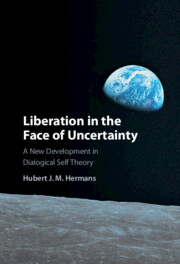Book contents
- Liberation in the Face of Uncertainty
- Liberation in the Face of Uncertainty
- Copyright page
- Dedication
- Contents
- Figures
- Tables
- Preface
- Acknowledgments
- Introduction
- Chapter 1 Playing with Plato
- Chapter 2 Centralization and Decentralization of the Self
- Chapter 3 The Other as Heaven and Hell
- Chapter 4 Re-enchantment of the World
- Chapter 5 Imprisonment and Liberation of the Self
- Chapter 6 Uncertainty in the Self
- Chapter 7 Multiple Well-Being and Other-Inclusive Happiness
- Glossary
- References
- Index
Chapter 2 - Centralization and Decentralization of the Self
Throughout the History of Philosophy
Published online by Cambridge University Press: 06 January 2022
- Liberation in the Face of Uncertainty
- Liberation in the Face of Uncertainty
- Copyright page
- Dedication
- Contents
- Figures
- Tables
- Preface
- Acknowledgments
- Introduction
- Chapter 1 Playing with Plato
- Chapter 2 Centralization and Decentralization of the Self
- Chapter 3 The Other as Heaven and Hell
- Chapter 4 Re-enchantment of the World
- Chapter 5 Imprisonment and Liberation of the Self
- Chapter 6 Uncertainty in the Self
- Chapter 7 Multiple Well-Being and Other-Inclusive Happiness
- Glossary
- References
- Index
Summary
In the history of philosophy, two lines can be distinguished, one represented by Plato, Augustine, and Descartes, emphasizing the centralizing movements in the self, another one embodied by Montaigne, Nietzsche, and Freud, proposing decentralizing movements in the self. As an example of present-day centralizing tendencies, the rise of meritocracy is discussed. An example of a contemporary decentralizing trend is the global–local nexus that implies a decentralizing multiplicity of self and identity. Whereas the centralizing movement in the self is focused on the realization of just one main form of positioning (personal excellence or superiority), the decentralizing movement results in the development of a wide variety of positions (full self-expression). Given this bidirectionality, the self is located in a field of tension resulting in an experience of uncertainty, or even stress, which challenges the dialogical self to liberate itself from imprisonment by alternating between centralization and decentralization.
- Type
- Chapter
- Information
- Liberation in the Face of UncertaintyA New Development in Dialogical Self Theory, pp. 34 - 71Publisher: Cambridge University PressPrint publication year: 2022

